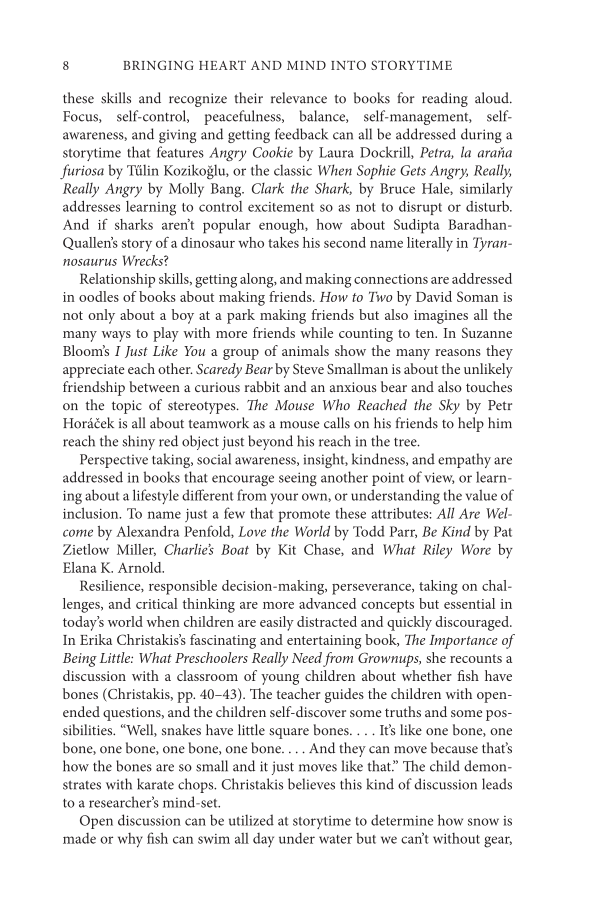8 BRINGING HEART AND MIND INTO STORYTIME these skills and recognize their relevance to books for reading aloud. Focus, self-control, peacefulness, balance, self-management, self- awareness, and giving and getting feedback can all be addressed during a storytime that features Angry Cookie by Laura Dockrill, Petra, la araňa furiosa by Tűlin Kozikoğlu, or the classic When Sophie Gets Angry, Really, Really Angry by Molly Bang. Clark the Shark, by Bruce Hale, similarly addresses learning to control excitement so as not to disrupt or disturb. And if sharks aren’t popular enough, how about Sudipta Baradhan- Quallen’s story of a dinosaur who takes his second name literally in Tyran- nosaurus Wrecks? Relationship skills, getting along, and making connections are addressed in oodles of books about making friends. How to Two by David Soman is not only about a boy at a park making friends but also imagines all the many ways to play with more friends while counting to ten. In Suzanne Bloom’s I Just Like You a group of animals show the many reasons they appreciate each other. Scaredy Bear by Steve Smallman is about the unlikely friendship between a curious rabbit and an anxious bear and also touches on the topic of stereotypes. The Mouse Who Reached the Sky by Petr Horáček is all about teamwork as a mouse calls on his friends to help him reach the shiny red object just beyond his reach in the tree. Perspective taking, social awareness, insight, kindness, and empathy are addressed in books that encourage seeing another point of view, or learn- ing about a lifestyle different from your own, or understanding the value of inclusion. To name just a few that promote these attributes: All Are Wel- come by Alexandra Penfold, Love the World by Todd Parr, Be Kind by Pat Zietlow Miller, Charlie’s Boat by Kit Chase, and What Riley Wore by Elana K. Arnold. Resilience, responsible decision-making, perseverance, taking on chal- lenges, and critical thinking are more advanced concepts but essential in today’s world when children are easily distracted and quickly discouraged. In Erika Christakis’s fascinating and entertaining book, The Importance of Being Little: What Preschoolers Really Need from Grownups, she recounts a discussion with a classroom of young children about whether fish have bones (Christakis, pp. 40–43). The teacher guides the children with open- ended questions, and the children self-discover some truths and some pos- sibilities. “Well, snakes have little square bones. . . . It’s like one bone, one bone, one bone, one bone, one bone. . . . And they can move because that’s how the bones are so small and it just moves like that.” The child demon- strates with karate chops. Christakis believes this kind of discussion leads to a researcher’s mind-set. Open discussion can be utilized at storytime to determine how snow is made or why fish can swim all day under water but we can’t without gear,
Document Details My Account Print multiple pages
Print
You have printed 0 times in the last 24 hours.
Your print count will reset on at .
You may print 0 more time(s) before then.
You may print a maximum of 0 pages at a time.







































































































































































































































